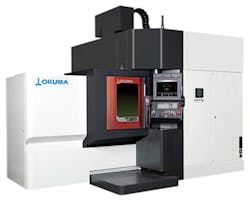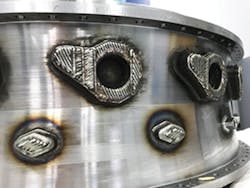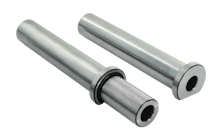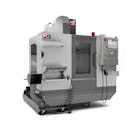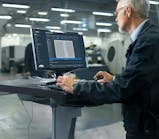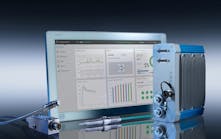Okuma America, a manufacturer of CNC machining centers, lathes and grinders, introduced its first multitasking CNC machine in North America in September. It employs hybrid manufacturing, which lets users move from subtractive to additive manufacturing and back again, said Paul Kingsley, senior applications engineer for Okuma.
The MU-8000V Laser EX is the company's first foray into additive manufacturing.
Many CNC machine makers are incorporating additive manufacturing into their equipment, Kingsley said. Much of the research in the last five years has been focused on laser metal fusion (LMF), in which a laser heats and melts a bed of metal powder to form successive, solid layers of a part. The process repeats until the finished part sits nestled in a bed of unfused metal powder.
But the MU-8000V Laser EX machine incorporates laser metal deposition (LMD) rather than LMF. LMD injects a stream of metal powder onto the substrate under the laser, which melts the powder and leaves a raised bead of metal in the laser's path, similar to the way welding adds material to a part. The more commonly used LMF process can't be used to add material to an existing part, Kingsley said. LMD yields several benefits, he said.
"A key capability of the LMD process is we can start with an existing metal part, such as a mold or die, and can add features to that part and then complete the finishing with a CNC tool, all in the same machine," he said.
The machine also has benefits over standard CNC machines. It allows tool and die makers to add on to a basic metal part to create features that can be difficult and expensive to create with CNC technology.
At the recent International Manufacturing Technology Show in Chicago, Okuma displayed a mockup of a turbine casing.
"If you look at the part, it is basically a big round cylinder, but it has a lot of features on it that are complicated and difficult to forge or cast," Kingsley said. "With the hybrid machine, we can place a more simply designed, near-net-shape forging in the work envelope. A user can add the complex features to the simple forging more easily using additive manufacturing. The part can then be finished all in one machine. This can significantly reduce the cost to make the forging and cuts the time to deliver the forging or finished part. This is the new technology complementing older technology."
HOW IT WORKS
With LMD, as one layer of metal cools, the next layer of melted powder is deposited on top of it.
"You are cooling down as you are building up. There is a lot of testing that is going on to ensure that the part ends up with the desired properties," Kingsley said. In most cases, parts made with LMD require finishing and, in some, a heat treatment to attain the final desired properties.
The MU-8000V Laser EX combines the capabilities of a traditional five-axis CNC machining center with a five-axis laser system. The machine is designed so users can swap between two types of laser nozzles.
The coax-type of nozzle delivers powder via a deposition head in 360 degrees around the laser beam and has a laser spot diameter — the size of the beam contacting the substrate — ranging from 0.4mm to 1.25mm. It has a low deposition rate and is used to produce parts with fine details. This laser can create a track just 50 microns deep and 50 microns wide. It can create beads of material up to 0.5mm wide and 0.25mm high.
"You are putting material down in beads, so the process has similarity to a welding process," Kingsley said.
Okuma also offers a "three-beam" nozzle. This nozzle can vary its laser spot diameter from 1.25mm to 8.5mm and delivers three streams of material to the laser beam. This combination allows users to build up more material in a single pass. It can create beads of material up to 6mm wide and 2.5mm high.
LMD makes it possible to 3-D print a part using multiple materials in a single build. The design of the MU-8000V EX Laser also allows parts to be inspected and repaired during production.
A key capability of the machine is that the range of laser spot diameters allows the user to tailor the accuracy, resolution and efficiency of the additive manufacturing process, Kingsley said.
MACHINE CAPABILITIES
The new machine has a variety of features to improve quality and safety.
Chips generated by CNC milling, along with coolant, are evacuated to prevent contamination of the work envelope during additive manufacturing.
The machine also evacuates airborne or extra metal powder left in the work envelope from additive manufacturing. Both powders and metal chips are removed by a proprietary vacuum system, Kingsley said.
The MU-8000V Laser EX has beefed up the protections of traditional CNC machining centers to allow it to safely combine additive and subtractive technologies in the same work area. To deal with the interactions of metal powder, machining scrap and laser heating, it has additional seals, positive pressure air purging, an additional or enhanced lubrication system, coolant system and conveyor system.
Okuma's hybrid machine surrounds its laser with a shield of argon gas during the build to protect reactive materials like aluminum or titanium that are prone to cracking if they are exposed to oxygen while in a molten state.
Okuma is looking at new developments to help lower oxygen levels to just 20 parts per million around the laser head and the part being built.
The MU-8000V Laser EX uses the company's standard control for its CNC machines. The tool paths for subtractive manufacturing and the laser paths for additive manufacturing can be created from the same CAD/CAM systems, Kingsley said.
FUTURE CAPABILITIES
Okuma believes hybrid machines might facilitate new manufacturing techniques. For example, machines of this type might be used to successfully deposit a wear-resistant material, such as tungsten carbide, onto a softer metal such as steel to create a wear surface. Typically, the tungsten would crack because of the differences between the coefficients of expansion of the tungsten and the softer metal. However, a hybrid machine may be able to lay down an intermediate material between the tungsten and the steel to eliminate the problem.
Okuma also is evaluating how multiple metal powders could be mixed at the nozzle and deposited on the part. The percentage of the metal powders could be varied on the fly, creating a part where properties vary in different regions.
The company also is looking at using the machine to coat a part with an Inconel alloy for wear resistance. It aims to replace expensive and toxic chrome plating with a process that coats and finishes the part in one machine. Other research looks at applying a hard steel to a soft metal like beryllium or aluminum.
Okuma is developing additional capabilities for future iterations of the machine. This includes laser case hardening for carbon steel. Okuma says less warpage is expected with case hardening in comparison to using flame or high-frequency methods.
Lastly, the company plans to improve the machine's ability to perform mold repairs on hard-to-cut and high-hardness metals. All operations, from crack removal in a mold to finishing, will be possible within a single machine.
Mikell Knights, senior staff reporter
Contact:Okuma America Corp. Charlotte, N.C., 704-588-7000,

